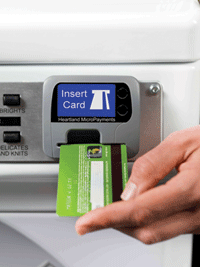 Florida students have more payment options thanks to wireless WaveRiders
Florida students have more payment options thanks to wireless WaveRiders
A new laundry payment and management system at the University of Florida accepts the GatorOne campus ID card as well as credit and debit cards.
The previous system accepted the campus card as well as cash, explains Mark Hill, assistant director of housing for Facilities Management at the school’s Department of Housing and Residence Education. The university made the switch because the mag-stripe reader on the 12-year-old machines often didn’t work making it difficult for students to use laundry on campus. “We’d seen a decrease in the usage of our machines on campus and in some cases it was because the card reader wasn’t functioning properly,” he explained.
The readers used in the system were out of production and getting replacement parts wasn’t possible, Hill says. To try and drive more student use of the laundry facilities the university decided to deploy the WaveRider system from Heartland Payment Systems.
Heartland’s WaveRider Laundry System offers wireless payment and account management and provides a secure method of accepting credit and debit cards to enhance convenience for students and staff.
Previously, when a student wanted to use the campus card to pay for laundry he would swipe the card at the room’s single, wall-mounted “gang” controller. Then the student would enter the number for the washer or dryer to be used, Hill says. With the new system each washer and dryer has its own magnetic stripe reader.
Each individual WaveRider reader communicates with a single room controller using the short-range Zigbee wireless standard. Up to 40 individual machines can be controlled by a single controller. The controller talks to the outside world via an onboard cellular modem to authorize payment transactions.
“The system meets all Payment Card Industry data security standards to protect cardholder data,” says Ron Farmer, executive director, Campus Solutions and Micropayments at Heartland Campus Solutions. Credit and debit card transactions are sent directly to Heartland for processing. This keeps campus networks and systems completely clear of payment card data, he explains. Campus card transactions, on the other hand, are sent directly to the GatorOne system.
In the past, UF laundry payments have been split fairly evenly between cash and the campus card. With the new system the university hopes to see campus card usage go up and cash usage decrease. “Based on our experience at other campus laundries, card use should go up dramatically,” says Farmer.
The campus’ laundry contractor, ASI Campus Laundry Solutions, deployed the new system in less than three weeks. The University of Florida has 520 washer and dryers for its 7,590 students in residence halls and 1,600 graduate students in university run apartments. The new system cost $220,000 to install and is expected to pay for itself over time, Hill says.
WaveRider features new reporting capabilities that can be run on a daily basis, which will make it easier to determine if a machine is out of service. “In the past we weren’t able to tell if a machine was working until a student complained but now we’ll be able to find out on a daily basis,” Hill adds.
The WaveRider system also features a Web-based portal called WaveVision that enables students to view the status of washers and dryers from a computer or mobile phone. They can register to receive text messages, alerting them when their laundry cycles are complete. “This helps reduce unnecessary congestion in the laundry room,” explains Farmer.
This online visibility is not unique to the Heartland solution but, according to Farmer, WaveRider is the only solution that provides it out-of-the-box with no extra hardware required.
Heartland has deployed the WaveRider system at a number of campuses and off-campus residence halls. “We’ve learned that student don’t carry cash and they love the convenience of using the debit card that is already in their pocket,” says Farmer.
According to Farmer, across their installations credit and debit card payments are most common at 41%, followed by student ID card payments at 33% and cash accounting for 26%.
“It is our objective to accept whatever someone has in their wallet in order to increase revenues for campus auxiliaries,” says Farmer. “We’ve designed all of our payment terminals–vending, printer, point of sale–to accept credit, debit and campus cards.”




